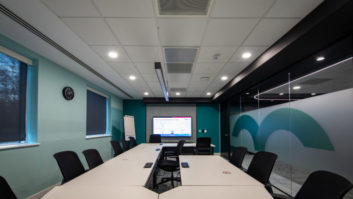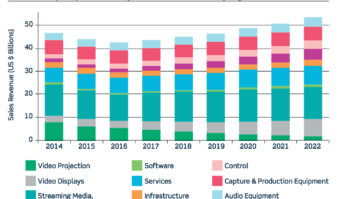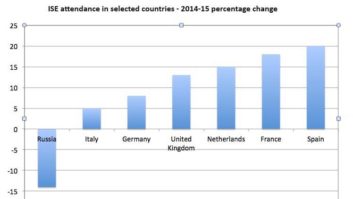After more than a year, the recession seems to be on its way out. So will 2010 mark a return to business as usual, or will some sectors remain sluggish? And which are the technologies to watch this year? Steve Montgomery reports.
Many questions are raised when it comes to thinking about what 2010 may hold for both the audio/video/lighting industry and the wider economy. What are the prospects for our industry? Will businesses learn to spend again or will they keep the tightened belt in place, or even tighten it more? And what prospects for new products? A wide range of manufacturers, system integrators and service providers gave us their views on what the new year might hold.
The general opinion is that we are over the worst. Carsten Steinecker, managing director, business development at distributor COMM-TEC, is very precise: “Overall the AV market upturn arrived in October; the question is: how sustainable will it be in 2010?” Gordon Innocent, chairman, RGB Communications, agrees: “We are just starting to see an upturn. In a survey of our customers taken in November, 60% said they too were already seeing evidence of an upturn. It seems likely that the gradual improvement towards the end of 2009 will continue slowly through 2010.”
The improvement is expected more rapidly in mainland Europe and the Middle East than in the UK. Tim Brooksbank, CEO at Calibre, says: “We’re seeing an upturn already in some sectors, particularly specialist areas such as medical, but large capital outlay items are still very slow. We are seeing many more enquiries for 2010 though and expect to see a good upturn by the middle of the year, but this will not be from UK business.” Graham Burgess, managing director of displayLED, explains how deep the recession went: “We have noticed an improvement in the past four months, not back to 2007 levels but certainly better than 2008 and early 2009.”
The US suffered badly at the start of the year but appears to have recovered earlier than Europe, according to Dave Duncan, education market development manager, Texas Instruments DLP Front Projection. “For many of our customers, AV is a ‘must-invest’ area,” he says. “As we look to the first shoots of recovery, users are becoming increasingly smart when it comes to AV, making strategic investments in technology that is affordable, requires little or no maintenance and yet delivers to the high specification that they demand. I fully expect these buying trends to continue through 2010 and beyond.”
Similarly, Bob Michaels, Magenta Research president, says: “A bottom formed in 2009. While we are starting to see some recovery in international markets, including Europe, we believe that the broader base of recovery will start in Q3-Q4 2010.” Robin Ford, VP business development at Global Caché, agrees: “The worst effects of the recession were in Q1 2009 here in the US. This was caused by a few customers cutting back on large orders, but recently there has been a steady return to regular business. We were seeing 30-40% revenue growth year over year. We won’t see that [in 2009]- ‘flat is the new up’ – so we feel OK about how things are going.”
Some companies, however, managed to reverse the trend: Steve Mattingly, managing director at TV One, asks: “When was the downturn? We saw consistent growth in our European and Asian sales throughout 2009. North America was level but even that has increased dramatically in Q4 to date.” Dale Miller, vice president, Christie EMEA, says: “2009 has definitely been a tough environment, but year-on-year Christie is looking at between 15 and 20% growth.”
Improving markets
New business is expected to come largely from the Far East, China and India; Mattingly adds: “China (Shanghai Expo 2010), South Africa (World Cup 2010) and India (huge expansion in TV stations) will all generate new business.” Brooksbank agrees: “We’re predominantly an export business, the recession hit us first but we’re coming out of it sooner than many because of this. Most of our business is into the US and most of the upturn we’re forecasting for the first half of [2010] is for Europe, particularly Germany and Scandinavia. We expect Far Eastern customers to see an upturn by Q2-Q3 2010. We don’t expect to see an upturn in the UK for another year though, if not longer.”
Market sectors likely to do well are education and corporate communications, as well as major government infrastructure projects and transportation. Franck Facon, worldwide marketing and communication director for Analog Way, is particularly clear on this point: “We expect rising demand from countries in which the pro-AV market is expanding, such as India, China and Brazil. Demand should also come from new customers. Indeed, interest in visual media is growing fast and it is spreading over every activity of our everyday lives. We can see good examples of this growth of AV when visiting a museum, when going to chain stores and in education. Although these are all very different sectors, they share the same interest for appealing new technologies.”
Environmental demands
The green factor is another driving force. For some vendors, such as Mattingly and Graham, green issues are seen to have limited effect on customer behaviour. Initial cost is still the primary consideration and education of ‘through-life costs’ is necessary as product capital costs decrease.
Mike Blackman, CEO of exhibition organiser Integrated Systems Events, has observed this green force: “While many companies are riding the green bandwagon for promotional effect, the AV industry can contribute a great deal to help – in particular in the provision of building and environmental controls that can save energy and money. It is this technology that will be influential in meeting and helping to form future government policies in this area.”
Individual devices are becoming greener, as Innocent explains: “Customers do like to keep their souls clean by buying into green technology, but not at any price. Unless prompted by government policy or initiative there has to be a real long-term saving or return on investment. More products will become greener, particularly with lower power consumption and intelligent power management.”
Michaels cites this as a major opportunity: “The green effect will be very important worldwide and will primarily be driven by end customers or, in some cases, legislation. A green solution in our market doesn’t necessarily come at a high price and the ROI is quick and easily quantifiable. Moreover, it presents an opportunity for manufacturers to differentiate.”
Green lighting
One of the areas to benefit will be that of lighting as we see more solid-state luminaires and finer control of them. Mark White, regional manager for the UK and Ireland at ETC, explains further: “We are seeing more integration of lighting with AV, although the biggest stumbling block is lack of compatible control protocols. This will change as energy-conscious specifiers and suppliers call for more integration, driven by government green regulation. In the longer term I foresee the development of plasma light sources in theatre lighting.”
While displayLED is also aware of market growth, Burgess is looking at “evolution, rather than revolution. OLED looks to be an interesting emerging technology, and creative lighting and media facades through the use of regular LED is something we are now addressing.”
Seamless integration
PSCo’s technical manager, Ed Martin, concurs: “Over the past few years there has been increasing convergence between lighting and display products, particularly in the events sector where LED lighting and content generators and servers are prolific. Architects and interior designers have also looked to achieve seamless integration using AV components with slimmer, larger, flat-panel displays, touch surfaces, brighter projectors, innovative screen surfaces and compact, controllable lighting. All of this contributes to the aesthetics of modern environments. There was an increasing interest in touch and gesture technologies across 2009 and the trend is unlikely to be anything other than upwards in 2010.”
Technology and new applications will be crucial in overcoming the recession. Futuresource Consulting in its recent Global Business Display Market round-up found a return to business growth for the displays industry in the third quarter of 2010 (see page 12). This is driven by a growing demand for large displays and visual communications generally, together with the associated video processing, support services and signal conditioning equipment. New techniques are expected to enable video walls and displays of any size and shape.
Brooksbank says: “In the past few years there has been a move to parallel processing for video, using software algorithms rather than pure hardware. The results were great but the R&D costs were high so the resulting products were relatively expensive and slow to bring to market. Hardware-based systems are getting better now with those software algorithms moving into silicon. This is making things more affordable, often at 35-40% lower cost.”
Digital signage, which had a good year in 2009, will continue to blossom, although content creation is long overdue a shakeup. Jason Cremins, chief executive officer of Remote Media, the company behind signagelive, reveals: “We are just about to launch the signagelive Virtual Player, which enables media channels to be hosted on the internet and accessed by thousands of TVs, mobile phones and Synchronized Multimedia Integration Language (SMIL) players all using a simple web address. The emergence of SMIL open standard hardware and media RSS-capable TVs and photo frames offers tremendous opportunities. The reduction in costs of hardware coupled with the power of signagelive to publish channels of media content will create disruptive price points for delivering digital media networks that will drive mass-market adoption.”
Connectivity and control will also influence design and application patterns, particularly as high-definition video becomes the video technology of choice and digital connectivity prevails. Innocent believes they will radically affect the market in 2010: “Connectivity is always a big discussion item in our market. We will see new technologies such as HDMI over IP, which will be game-changing for AV distribution.”
Similarly Brooksbank maintains that it is a crucial technology area. “People continue to hate HDMI with a passion, partly because of HDCP making it quirky and unreliable and because of the awful unreliable non-locking connectors,” he explains. “HDMI 1.4 has been a non-event for our sector [image processing], but 3G-SDI is of great interest since it’s a high-quality connection method with sensible connectors, sensible cabling and acceptable cable cost. The interface is expensive but the ongoing ‘consumables’ cost of cables is reasonable compared with HDMI. Unfortunately, HDCP seems to be here to stay, so what the industry really needs is a means of running HDCP over 3G-SDI.”
Steinecker too believes that digital connectivity will be the basis of the next revolution, and affordable signal management solutions such as HDMI over IP will challenge established and mainly analogue products. New remote-control devices are also expected, as Ford highlights: “We’re excited about the iPhone becoming a universal remote control for entertainment systems and a front end to a whole home-control system. We can connect almost anything electrical to a WiFi network and it gives us an advantage over any competition.”
An alternative technology for wireless video distribution, particularly suited to the domestic environment, is promoted by the WirelessHD Consortium. Its chairman, John Marshall, explains: “WirelessHD using 60GHz radio frequency is maturing as a technology and being incorporated into a range of products from mainstream manufacturers. In 2010, we will see WirelessHD evolve as it is integrated further into devices such as HDTVs, Blu-ray players and AV receivers.”
High-impact offering
The technology most likely to have a great year is 3D. Duncan says: “Despite the recession we are seeing increasing demand for new innovations and technology from our customers. As we move into 2010, one of the biggest areas for DLP will be 3D projection. What is crucial is that manufacturers using projection technology such as DLP are now able to bring 3D to the market at an affordable, mainstream price point. While we expect the market to show signs of recovery in 2010 we are still aware that a number of sectors are still highly price sensitive. 2010 will see AV vendors continuing to bring to market the very latest projection technologies, but at even more affordable prices.”
Miller says: “3D is probably the next big thing, it started [in 2009] in the cinema industry. We’ve been pioneering LED in the control room and simulation markets, where we are now exceeding customer requirements. We believe it to be the future for control room environments. 2010 will also see the availability of 4K DLP chipset in our D-Cinema solutions and a major revolution with the introduction of modular digital display tiles that can be stacked and clustered like building blocks to create display walls of any shape or scale.”
Mattingly predicts: “2010 will see 3D-HD being broadcast in Europe, which will spark enormous interest for other applications using this technology with live 3D effects and image manipulation.”
projectiondesign is shortly to launch a new line of image processing equipment, as explained by Anders Løkke, international marketing & communications manager: “The MIPS WB2560 is an all-new multi-image processing system offering state-of-the-art high-performance image blending and geometry correction for 2D and 3D display in scientific visualisation, training and simulation applications in the military, security, education and aerospace sectors.”
There is optimism in the industry at large, with a generally positive outlook for 2010. Whether or not individual governments are affecting the recession is debatable, but it is clear that most players in the AV market expect growth and an end to the troubled times of 2009.
A note of caution, though: as the industry recovers faster than other parallel industries, such as data communications and IT, we should expect suppliers and integrators in those fields to encroach on the business of AV. This is already happening to some extent through convergence between the technologies, as AV content becomes a commodity item that is distributed over networks and through computers, rather than the stand-alone technology that it has been in recent years.







